The coral reefs of the Seychelles are one of the most beautiful and fragile ecosystems in the world.
But scientists have now discovered a “coral superhighway” that could be key to helping these stunning natural wonders survive.
Despite being dispersed over more than 540,000 square miles (1.4 million square kilometers), scientists discovered that corals from remote reefs are actually genetically related.
Researchers at the University of Oxford say this is the first evidence of a vast network of ocean currents that have been helping to transport coral larvae from one reef to another.
The findings come shortly after experts warned that the Great Barrier Reef’s coral reefs are in “grave danger” amid the worst bleaching event in history.

The remote reefs of the Seychelles (pictured) are some of the most beautiful but fragile ecosystems in the world.
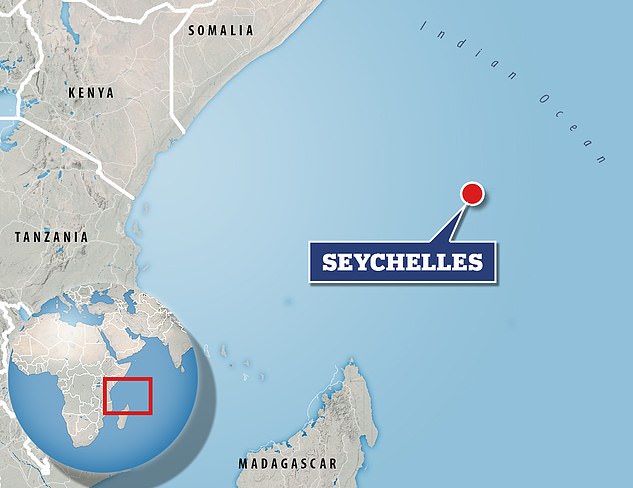

Researchers have discovered a “coral superhighway” of ocean currents that transport coral larvae from one reef to another and could be key to helping Seychelles reefs survive.
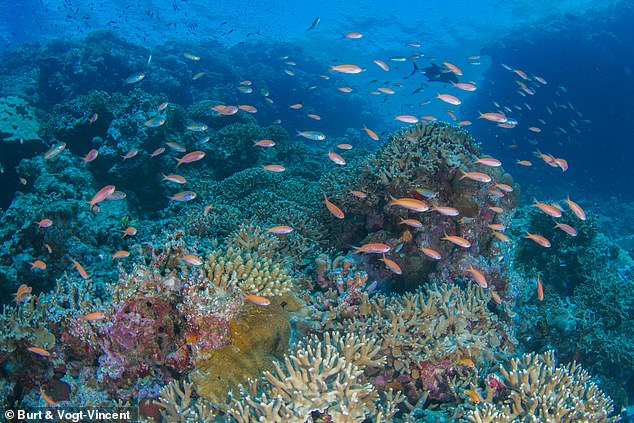

Using genetic analysis on coral samples from 19 different sites like this one, the researchers found that the scattered reefs had a strong genetic connection.
With the help of the Seychelles government and local reef management organizations, researchers collected coral samples at 19 different sites.
Using genetic analysis, the researchers found a surprising level of similarity between different coral populations.
This was an unexpected result as previous ocean simulations had suggested that there should only be a limited connection between the outer islands and the inner islands.
However, using a more detailed ocean model, the researchers found that the genetic connection patterns closely matched the patterns of ocean currents.
This suggests that when coral larvae spawn, they can be transported many thousands of kilometers before finding a new reef to settle and grow.
Dr April Burt, lead author of the study, said: “This discovery is very important because a key factor in the recovery of coral reefs is the supply of larvae.”
The researchers discovered that corals generated in remote Aldabara had spread westwards towards the east coast of Africa, via the East African Coastal Current.
From there, the corals would be swept north along the coast to the point that some would eventually reach the southern equatorial countercurrent, which would take them back east toward the inner islands of the Seychelles.
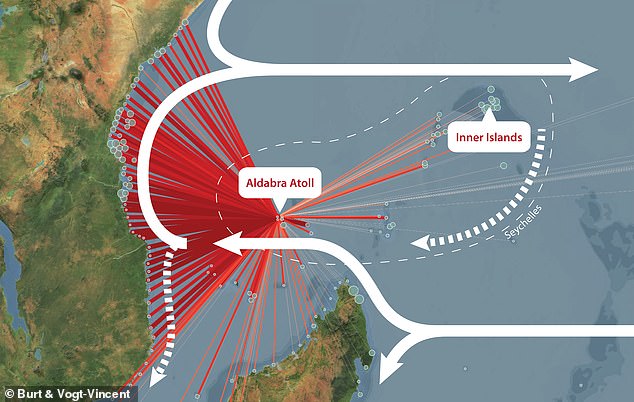

As this diagram shows, ocean currents can transport coral larvae from the remote Aldabra Atoll westward towards Africa, before traveling north and returning east to reach the interior islands.
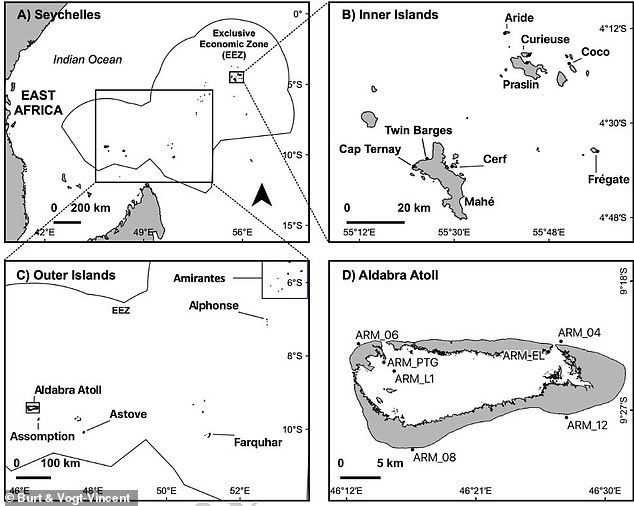

These maps show the distance between the different reefs in the Seychelles.
Researchers believe this discovery could be vital for the future conservation of Seychelles’ coral reefs.
Seychelles’ reefs have already been devastated by mass bleaching events in which changes in temperature or light wipe out large amounts of coral.
In 1998, a particularly devastating event killed 90 percent of living corals.
In their paper, published in Scientific Reports, the researchers write: “Projections for its long-term survival are grim, and bleaching is projected to become an annual event over the next 15 to 40 years.”
However, the outer islands of the Seychelles appear to be less affected by bleaching, suggesting that they could host species more resistant to bleaching.
If these species can travel across the Coral Superhighway to the Inner Islands, then they could replenish at least part of the reef.
But while long-distance travel is possible, the researchers suggest that the coral travels primarily by “springboard dispersal,” jumping from reef to reef.
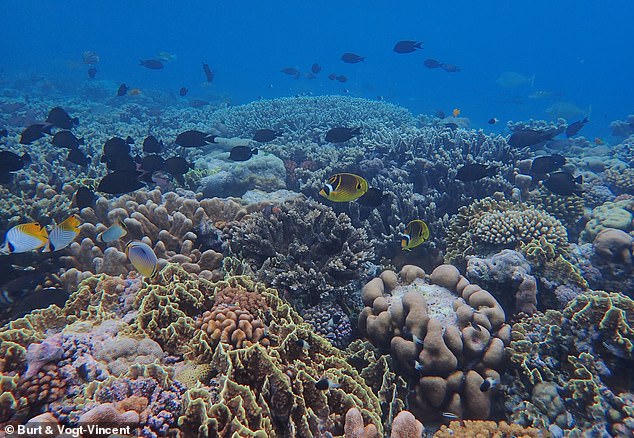

Coral bleaching events have been hugely damaging to reef populations like this one on Aldabra Atoll, but some more resilient species have survived.
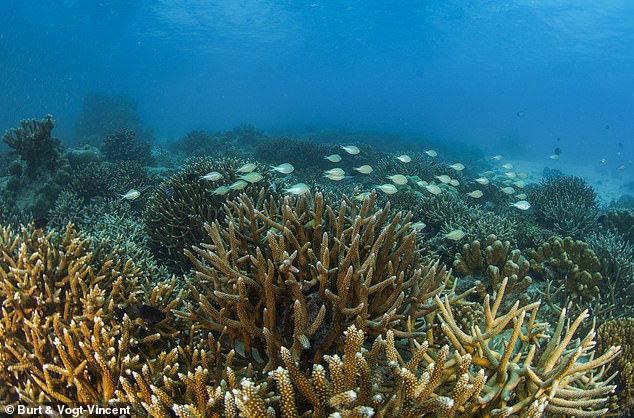

Researchers believe the highway could transport bleach-resistant corals from one reef to another
This means that choosing the right reefs to protect can help ensure that there is a chain of connection between bleaching-resistant populations and the most vulnerable reefs.
Dr Burt says: “Although corals have declined alarmingly around the world due to climate change and a range of other factors, action can be taken on a local and national scale to improve the health and resilience of reefs.
“These actions may be more effective when we better understand the connectivity between coral reefs, for example by prioritizing conservation efforts around coral reefs that act as important sources of larvae to support regional reef resilience.” “.
The researchers now hope that their discovery of the coral superhighway can help the Seychelles government and environmental groups target their efforts more effectively.
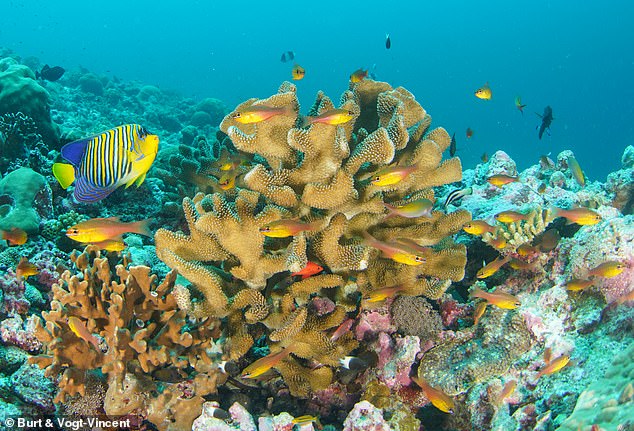

By preserving suitable reefs, coral larvae can travel from place to place using reefs like this one in the Seychelles as stepping stones.
Dr Noam Vogt-Vincent, who led the modelling, said: “These simulations also allow us to investigate how regular these connectivity patterns are over time, because a regular supply of larvae will be essential for reef recovery in the face of climate change.”
These efforts will be especially vital in the coming years as rising ocean temperatures threaten to create mass bleaching events.
This year, studies suggest that the El Niño climate phenomenon could cause record high temperatures.
Under a moderate El Niño, the global mean surface temperature will be 1.8-1.98°F (1.03-1.10°C) above average, while a strong event will cause temperatures to drop. Elevate between 1.9 and 2.16 °F (1.06-1.20 °C). above that average.
Professor Lindsay Turnbull, lead author of the paper, added: “The world is once again watching as El Niño devastates coral reefs across the Indian Ocean.
“We now know which reefs will be crucial to coral recovery, but we cannot stop in our commitment to reduce greenhouse gas emissions and stop climate change.”
